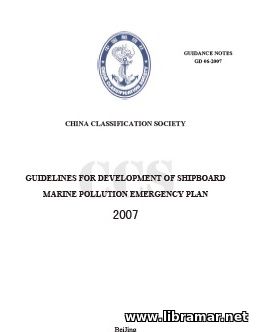 The official guidelines issued by the China Register for the development of the SMPEP, i.e. ship marine pollution emergency plans. Subject guidelines have been developed to provide assistance to the people dealing with the SMPEP for the vessels carrying noxious liquid substances, as required by MARPOL Convention Annex I/Regulation 37 and Annex II/Regulation 17, and will be useful to the owners, operators and managers of the vessels.
The main content of the guidebook is arranged in two chapters. The first chapter contains general provisions including application and purposes of the document, general requirements for SMPEP development, and its examination and approval. The second chapter is solely devoted to the development of SMPEP, providing the reporting requirements, steps to be taken to control the discharge, local and national coordination, etc.
There are two appendices providing the information on the approval of SMPEP and sample plan that can be used for reference.
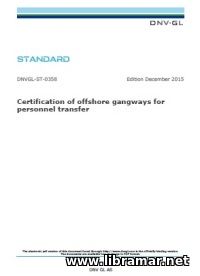 The officially released DNV GL publication providing the information about certification of the personnel transfer gangways commonly used offshore. The document will provides required technical info and safety guidelines addressing both design of the gangways and their certification with the ultimate aim to contribute to the development of the alternate solution for manning offshore facilities.
The authors of this offshore standard recommend it to be used as a reference source for better understanding of the role played by the gangways in the manning of the offshore facilities prior to proposal of the design. The standard will provide designers and engineers with the technical criteria and guidance for the certification of this equipment and verification of their design, materials the gangways are constructed of, fabrication and installation of the gangways, and their post-installation testing and commissioning.
The requirements that shall be met in order for the product certificate be issued have also been provided. Particular attention has been paid to the functional and procedural requirements as well as to the safety equipment. In short, the document covers all aspects of the gangway design/certification.
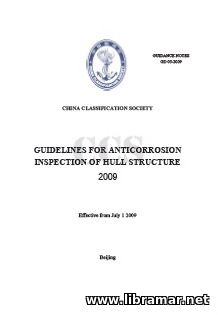 The Guidance Notes no. GD 03-2009 by China Classification Society. The Guidelines for Anticorrosion Inspection of Hull Structure have been developed in order to improve the effectiveness of the corrosion control of steel structure for vessels, extend the service life of such structures, and of course prevent any possible structural failures that may be caused by undue anticorrosion measures taken.
The purpose of the Guidelines is to provide guidance for anticorrosive design, construction and inspection of ship's steel structures. The Guidelines provide operational guidance to the flag State Governments with regard to mandatory implementation of, or to the owners with regard to voluntary request for implementation of IMO technical requirements related to the protective coatings for specific spaces of ships.
The Guidelines apply to the concerned design, construction and inspection of the coating application, sacrificial anodic protection, impressed current protection for ship's steel structures required by the CCS Rules and/or entrusted. The Guidelines are also references for steel structural anticorrosion of offshore installations, marine products and other industrial products.
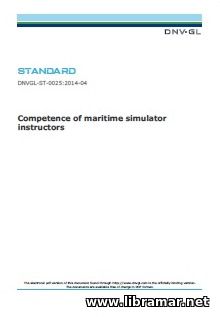 The present official standard prepared and officially published by DNV GL is focusing on the performance-areas of instructors who are directly involved in training/education using maritime simulators and is addressing all operational areas that are relating to the design, delivery and assessment of learning programs.
Along with the generic competencies for those who are involved in transfer of skills and knowledge, specific simulator-related competencies have to be addressed separately. The simulator instructors need know how to to properly prepare and deliver the training program he is assigned to and also verify that students at the end of the program have indeed met the initial learning objectives. The present standard is intended to specify the competence requirements applicable to the simulator instructors who can be considered responsible persons for the design, delivery and/or assessment of a learning program involving the use of maritime simulators.
Again, traditionally, there are three parts in this standard: introduction - scope, target groups and professional profile, plus required performance standard, taxonomy - general info, cognition levels, and professional behavior verbs, and competence requirements.
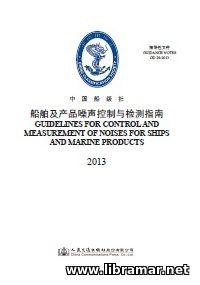 The officially released CCS guidelines for conducting the measurement and control of noise on board ships. The intent of the guidebook is to provide effective methods of noise prediction and required measures of control for the vessels plus the methods of measuring noise on board, with the aim of verification of the measurements for their compliance with the requirements applicable to particular compartments of ships or other marine structures.
These guidelines apply to the vessels with the gross tonnage exceeding 1600 engaged in international passages. The content of the guide is arranged in four major parts. The first part provides the general introduction including technical provisions and verification of compliance. The second part is devoted to the control of noise and describes the noise control procedure, noise prediction and sources of noise as well as the measures to be undertaken to attenuate noise.
The third part is dealing with the noise measurement for marine products and addresses the airborne and structureborne noise, sound reduction and the approval requirements for the organizations conducting noise measurement. Finally, the fourth part covers the noise measurement on board ships and deals with the noise exposure limits and their correct determination, tools and calibration, institutes and personnel involved, and many other important aspects to consider.
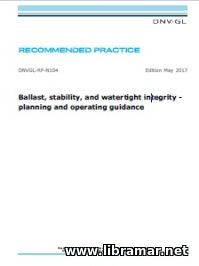 The RP, i.e. Recommended Practice, released by DNV-GL and providing required guidance for the planning of the ballasting operations, stability of the vessel and watertight integrity of the hull. The guidebook starts with the chapter providing general information including intro and description of scope and objective, structure of the document, and abbreviations/definitions used.
The main part covers the management of significant themes including design and equipment, stability and integrity, ballast and bilge systems, inspection of the subject arrangements, their repair and periodic maintenance, associated documentation, training of the personnel involved etc. Then, we move to the development of the operational guidance and its subsequent implementation on board, including the comprehensive overview of the operating guideline, pre-mobilization checks, and execution requirements plus other relevant information.
There are several appendices in the closing part of the booklet providing the supplementary information, such as the implementation matrix, AMOG development/implementation process flow and associated check sheet, examples, MOM guidelines etc.
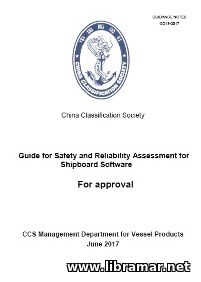 The official guidance notes developed and released by Chinese Class Society, CCS. This document is intended to provide required guidelines to be applied for the assessment of the reliability and safety of the software used in the computer systems installed on board, including programmable e-systems. It is specifying all relevant technical requirements concerning the development and testing of the software, its authentication, production and subsequent maintenance.
In addition, the document also addresses the requirements applicable to the hardware part of the systems. The main focus has been made on the life cycle of the software development, adopting some major processes in the integral cycle. The authors of the guide adopt the V model as the development model. The documents opens with the chapter defining its scope and providing the descriptions, followed by the list of normative references, abbreviations and terms used throughout the guide. Then, the information is provided covering the categorization of the shipboard computer systems and requirements applicable to the quality system, lifecycle of the system and of the software development.
The last chapter is devoted to the test and verification of the systems. Three appendices touch the verification procedures for the inspections and tests, evaluation of the low complexity systems and technical recommendations to be considered during the design and implementation.
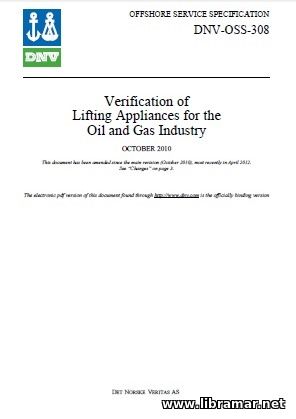 This offshore service specification was prepared and published by DNV class society to give readers the criteria for and proper guidance of lifting appliances used in the oil and gas industry within the EEA, i.e. European Economic Area. It falls under the core document DNV-OSS-300. The arrangement of the specification is pretty standard, as it it the case with the specifications covering verification of process facilities, verification of subsea facilities, verification and certification of submarine pipelines and others.
Again, the first chapter provides the very general knowledge of the risk-based verification, abbreviations and definitions used throughout the document, info on the verification plans etc.; in addition, this section describes the reports and certificates issued by DNV to the lifting appliances. The "Service overview" section explains the process itself as well as verification documents.
The instructions on proper selection of the verification level are also there, supplemented with the trigger questions, explanation of the life cycle of the lifting appliances, some technical terminology, verification documents, use of QMS and some other relevant information.
« 1 2 ... 15 16 17 18 19 ... 29 30 » |







